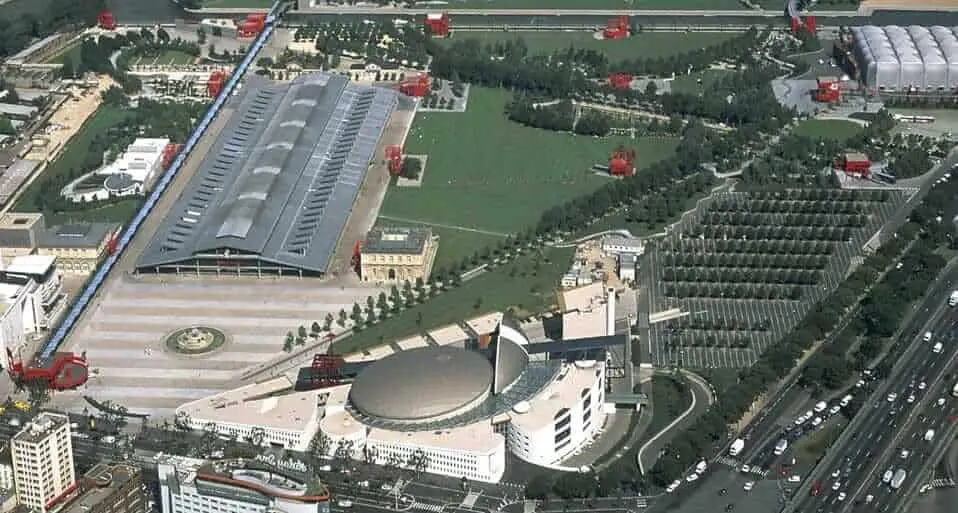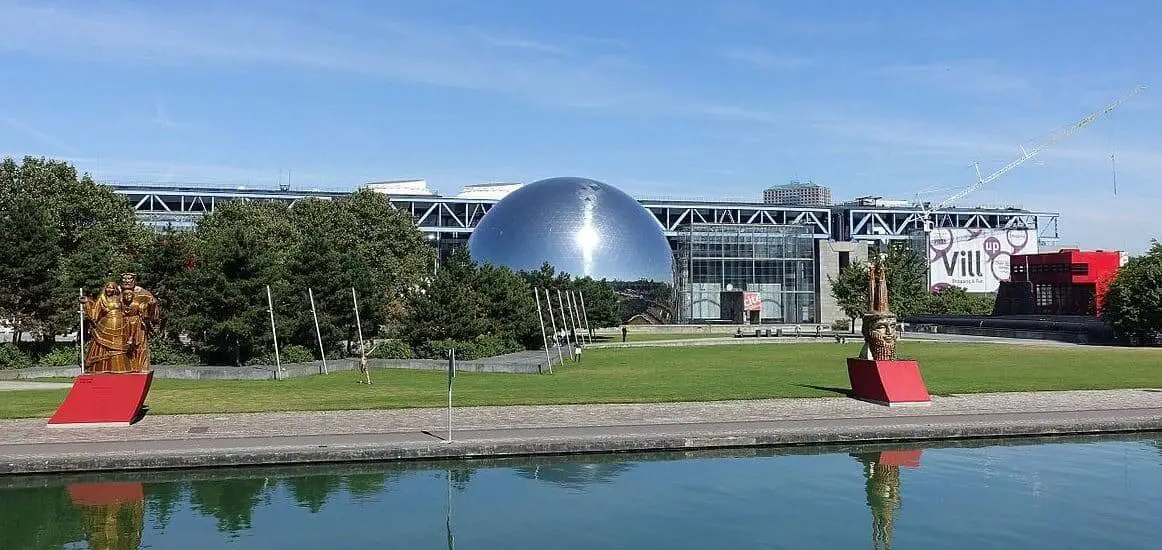This article highlights a new concept of park landscaping in paris named Parc de la villette which helps to clarify things to people about French Architect Bernard Tschumi and how he has designed for one of the few remaining large sites available within the city of Paris, which became the Parc de le Villette.
INTRODUCTION:
The Parc de la Villette is one of the largest parks in Paris, designed by French Architect Bernard Tschumi.It has a total area of 125 acres. The park has 186,000 sq.ft. of restaurants, art workshops, music pavilions, recreation facilities and gardens, as well as 70,000 sq.ft of galleries and bridges and 70 acres of landscaping. The Parc de la Villette’s conceptual framework allows for multiple combinations of various activities which happening inside the built-up area. It combines areas for nature, planning and architecture by organizing the landscape with the buildings in side the park, play and leisure. Thirty-five follies (contemporary red coloured structures are an ideal place to visit and sitting over there) are placed on a grid and offer a distinct organization to the park.

DESIGNER BACKGROUND:
French Architect Bernard Tscumi had childhood background in Lausanne, Switzerland and half in Paris, France because his mother was French and his father was Swiss. His father studied architecture in Paris, and at the end of WWII he set up the School of Architecture of the Ecole Polytechnique in Lausanne. Because Tscumi spent so much time in both Lausanne and Paris, he felt that he was not limited to having only one nationality. As an adult he enjoyed living in New York because he felt there was no such thing as “nationality” there.
HISTORY:
Bernard Tschumi won a major design competition in 1982–83 for designing the park. He built it from 1984 to 1987 on the site of the huge Parisian abattoirs ,which is a slaughterhouses built-in 1867, had been cleared away and relocated in 1974.The Parc represents a new model for the 21st century city park in which program, form and ideology come together. There are two strong elements on the site of the history. First,it was the former site of a slaughter-house that employed more than 3,000 people. Second, two canals run through the site. The Ourcq canal supplied water to the city of Paris and the St. Denis canal was used to transport cargo and freight. The Parc de la Villette includes one of the large slaughterhouse buildings and both canals.
Related: Road Landscaping – Urban & Regional Roads | Objectives, Need, Methods
LOCATION:
Parc de la Villette is located on the edge of Paris in the middle of a semi ndustrial, working class district that borders on the suburbs. It is situated in the northeast corner of the city, between two subway statiorns. Accoring to Tschumi’s the Parc de le Villette shouldn’t be designed as a park but a new type of city. The main fact that he started with an old industrial site, he decided that the park is anti contextual has no relationship to the surrounding and subverts border on which the context depends on because he believes the park would function well within the city.
PARK ATTRACTION & ACTIVITIES:
Parc de la Villette is over one kilometer long and seven hundred meters wide, and the major activities are taking place on the main attraction points of the whole entire park which are the following below:
- Cite des Sciences et de l’Industrie which is City of Science and Industry,playing role as a biggest science museum. It has open air cultural center with space for workshops, gymnasium and bath facilities , playground, exhibitions, concerts, scientific experiments, games and competition in addition to the buildings already existing on the site.
- Cite de la musique is a museum of historical musical instruments with a concert halls, is a group of institutions dedicated to music with a green open space which has designed with great landscape . The intensity of the activity is high because the people can enjoy here the both together, the nature & music concert.
- Le Zenith is a 6,300 seats concert arena situated in the park.
- Cabaret Sauvage which is also a flexible small concert stage with 600 to 1,200 seats,a synonymous of theatre which catches lot of activity.
- Le Trabendo, a contemporary 700 seats venue for pop, rock, folk music, and jazz, a major entertaining part of the park.
- Theatre Parc-Villette, a small 211 seats actors theatre and also its acting workshop.
- Cinema en plein air, an outdoor movie theatre, site of an annual film festival.
- Grande halle de la Villette, a historical cast iron & glass abattoir that now holds fairs, festive cultural events.
- Philharmonie de Paris, a new 2,400 seats symphony hall for orchestral works, jazz, and world music, currently under construction and due to open in 2014 live performance stages.
- La Geode, an IMAX theatre inside of a 36 meters (118 ft) diameter geodesic dome.
Except these all, playgrounds with landscaping is visible for children where a huge branch of activity is taking place and the most important thing is thirty-five architectural follies which placed in a certain distance on whole entire the park which is the another point of generating the activity.

FOLLEY :
It is the point of cultural activities inviting all the musicians, artist to produce their performance, which help all the people to interact each other in the society. The follies are meant to act as points of reference that help visitors, gain a sense of direction and navigate throughout the space. These amazing differently shaped red structures which is called Folley some of which are merely ornamental, and others having a range of functional uses in Parc de la Villette. Some of follies serve functional purposes such as informational kiosks, refreshment stands, or souveir shops. Others provide a precipice from which people can view the grounds of LaVillette.
Related: Strategic Environmental Assessment
BUILDINGS IN LANDSCAPE:
Bernard Tschumi’s used the system of points, lines and planes to place the building in suitable place that can help to generating the landscape in the park. The most important of these are the points consisting of a grid of follies small cubical structures that can be transformed for variety of uses. Inside the theatre building, there are various cultural activities are happening ,according to these landscaping has been provided in a circle surrounded it.
DESIGNER’S INTENT IN SPATIAL ORGANISATION:
Bernard Tschumi’s main intent was to include huge variety of cultural activities, It is successful in creating the experience of nature within the city, he decided the point-grid system worked best. The three systems that comprise the Parc consist of a system of surfaces, a system of lines, and a system of points.
- The surfaces of the park host activities that include game playing, exercising, entertainment, markets and more, and appropriate surfaces are used for each activity. Remaining surfaces are constructed of compacted earth and gravel and are more free and varied in form.
- The lines of the parc are supplied by a grid of Folies the orthogonal system that guides pedestrian movement and the Path of Thematic Gardens, the path that intersects the coordinate axes and provides unusual and unexpected encounters with nature.
- The points are a grid system of Folies placed at 120 meter intervals that serve as a common denominator to the entire park. They are 10x10x10 meter cubes that can be changed to accommodate specific needs. The strict repetition of the Folies creates a recognizable symbol for the park. Each Folie functions as a marker and a unique space, an area for experimentation that is linked to a group or event. The Folies replace static, traditional park monuments and will be future reference points for emerging social and artistic change in an evolving society.
MOVEMENT:
It provides an opportunity for city folk to relax and fill their lungs with oxygen in this vast domain, on foot or on a gentle cycle ride.
The north-south axis joins the two subway stations and the east-west axis joins Paris to the suburbs. It has no walls, no gates, no railings and is open from 6am to 1am for visiting the park by walk or cycle.2 walkways have been designed for visitors in a hurry: the first crosses the Park from the Porte de Pantin to the Porte de la Villette; the second, is elevated and runs along the south bank of the canal. The waterway has been designated for use by pleasure craft. The access to the houses were arranged in such a way that it was from the public road outside the park , there were no access from inside the park. It was done in such way that it should not , appear to be the property of the houses which Surrounded it.
CONCLUSION:
The intentional design of Parc de la Villette was not to be a park in the traditional sense ,even it has been designed as the basis of planning context..It needs to complement the vision of the city so that the city will exist within the park and embrace urban reality. Landscape isn’t only just scenery, it is more than that, it is the interaction between people and place. This park has designed to keeping in mind this concept. In French, “La Villette means little city.” Through the force of his revolutionary design, Tschumi was able to anticipate the future of Paris in his gift to the city—the Parc de le Villette.
REFERENCES:
- Tschumi, Bernard. Cinégram folie, le Parc de la Villette / Bernard Tschumi. Princeton, NJ:Princeton Architectural Press, 1987.
- Parc de la Villette, Paris Bernard Tschumi designer,J. Daniel Pugh LARC 263,November 16, 2004.
- Contemporary perspectives and transforming the strategies of industrial landscape by Julia R. Verady, BA.